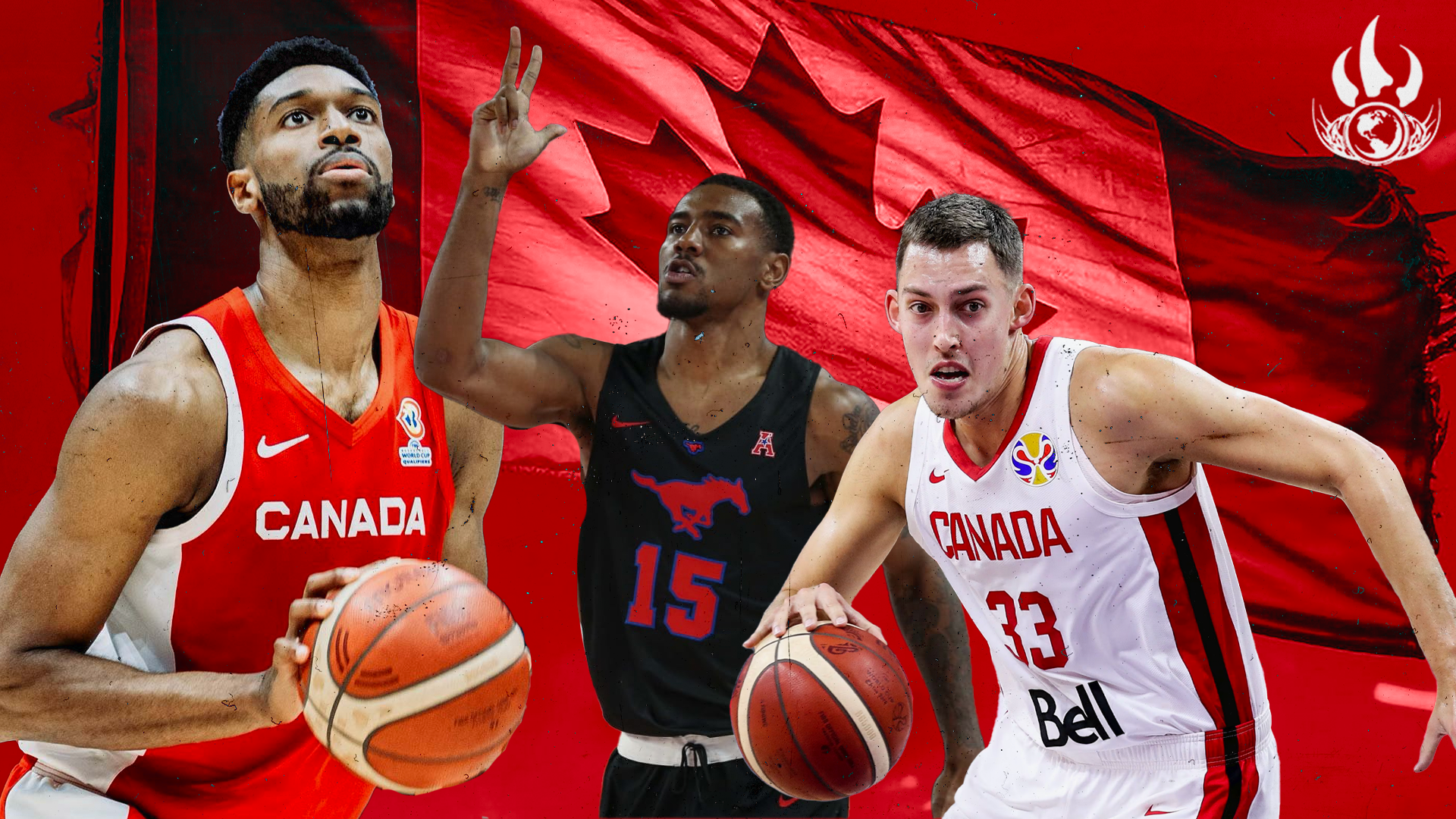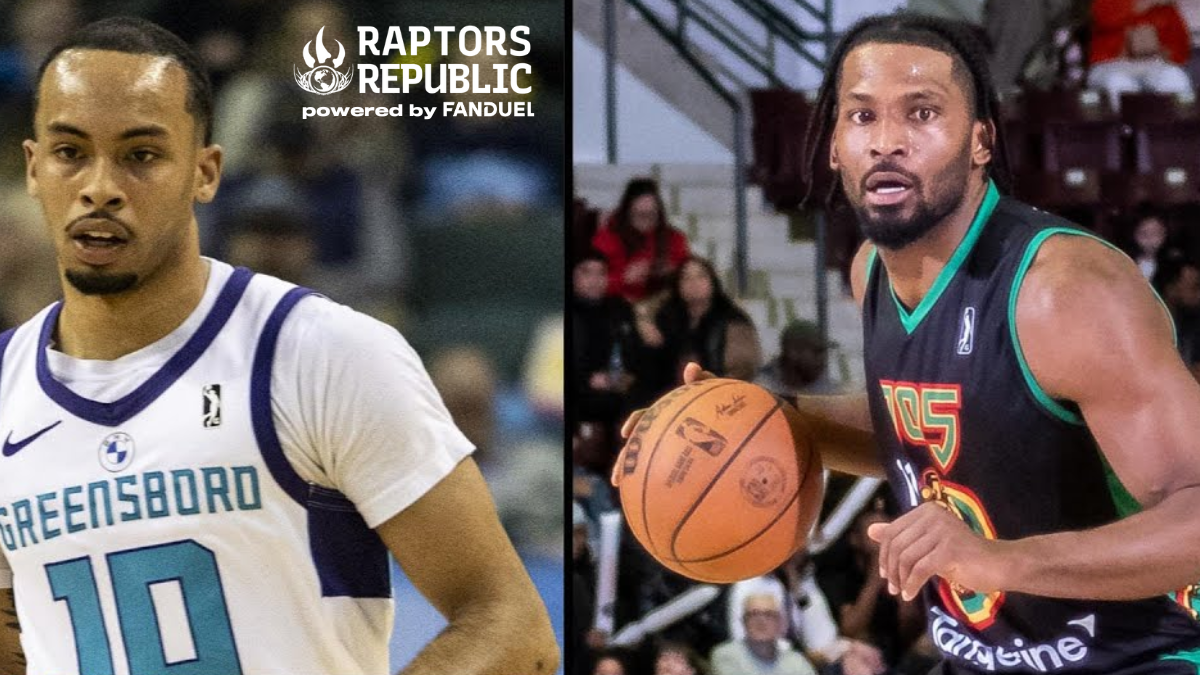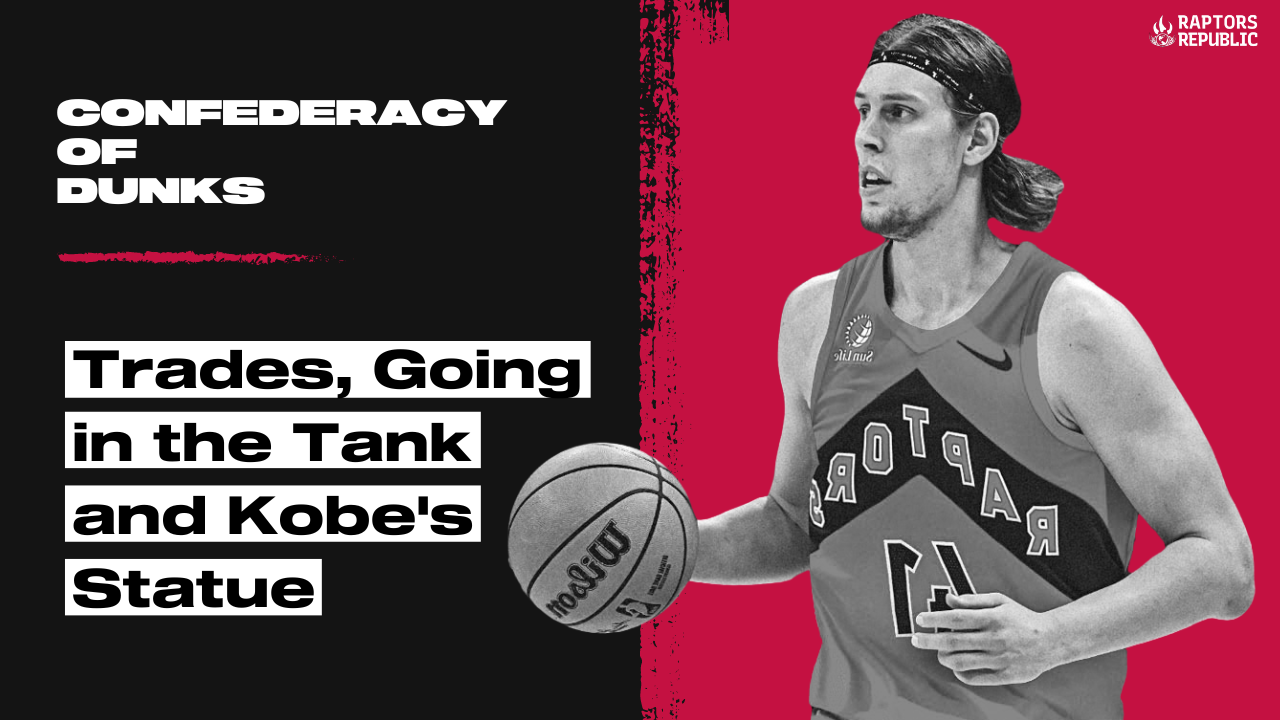While the Canadians have collectively struggled in the EuroLeague this year, the Canadian contingent in the EuroCup (the 2nd-tier European continental competition) has found immense individual and team success overall. With the SMNT, many of these pros have been key contributors to the “Winter Core”, while others have yet to represent Canada on the international stage. Regardless of their prior FIBA experience, I believe that each of these players covered in today’s Canadian Roundup can and should play large roles for Canada Basketball moving forward.
Kyle Alexander
Out of the 4 European pros who represented Canada at the 2023 FIBA World Cup, I was the most excited to see Kyle Alexander. In fact, if you follow me on Twitter, I have been driving the Kyle Alexander bandwagon for months. After all, he was the only one with EuroLeague experience, playing the 2022-2023 season with Valencia Basket (home to Kevin Pangos and Kassius Robertson this season who I covered a couple weeks ago) and his physical tools and defensive versatility were incredibly impressive. Despite not playing a large role at the World Cup, I continue to believe in Alexander as a high level starter with the “Winter Core” and a legitimate rotational player with the “Summer Core”. I would be 100% on board with Alexander representing Canada at the 2024 Olympics, providing elite rim protection for a team that sorely lacks it.
After struggling in his rookie season in the EuroLeague, Alexander went down a level this year and signed with Hapoel Tel Aviv where he’s shined in a key role. Starting all 17 EuroCup games this season and boasting an insane +9.4 NETRTG according to 3stepsbasket, Alexander has helped propel Hapoel Tel Aviv to a 2nd place finish in Group A. In terms of individual production, he currently ranks 3rd in the league in BLK at 1.5, 6th in REB at 7.7 and 14th in PIR (Performance Index Rating) at 17.4. PIR isn’t the most comprehensive or advanced stat in the world as it is just a simple sum of “positive” actions (points, rebounds, blocks, assists, etc.) subtracted by “negative” actions (misses, turnovers, fouls, etc.), but the overall point stands. Kyle Alexander has been an elite EuroCup player this year.
Diving into the film and Alexander’s mobility as a rim protector continues to jump out. He flips his hips effortlessly for a 6’10” big and can explode off the ground with minimal load up time. Alexander combines those physical tools with a 7’5″ wingspan, making him an incredible rim protector, especially on the move. He is clearly an NBA-level rim protector
Like just look at how ridiculous this screenshot is, where Alexander is able to get his fingertips on a ball that’s above the white square! It’s even more impressive when you realize Alexander was able to get this high off of the ground with a quick 2-step gather in pursuit of the PnR ball handler. This is truly mind-boggling defensive stuff.

One thing I do think Alexander needs to work on is his defensive positioning. While his mobility and athleticism give him a larger margin of error to recover, Alexander can get caught out of position, especially when defending PnR’s with hedge/blitz defensive coverages. He’s already a good drop big and can hold his own when switched onto the perimeter. His defensive value would only increase as he adds more versatility in the defensive schemes he can effectively execute. The following two clips from the same game vs Besiktas show his awkward positioning, setting the edge far too wide and creating an easy pocket pass window for the opposing guard. This is something Alexander is going to need to clean up as he gains more experience playing high level professional basketball.
On the offensive end, Alexander has continued to be his low-usage, highly efficient self. With a TS% of 68.6% (87th percentile), I think he’s already a neutral-slight positive offensive player at the highest levels. I was really intrigued this season with Alexander’s midrange shooting. At the end of the regular season, he was producing 1.17 PPS (points per shot) on 8% frequency from the midrange. It’s obviously a very small sample size (just 13 shots overall in 17 games), but I think this is the next area of development for Alexander. Shooting a career high 75.0% from the free throw line is an encouraging sign for some shooting development but it remains to be seen if he can make the jump to a clear positive on offense.
Isiaha Mike
Isiaha Mike might be the most under the radar Canadian overseas gem currently. A diamond in the rough, if you will. At just 26 years of age, Mike has slowly climbed up the ladder of European professional basketball and has turned himself into a strong EuroCup level player in just 4 years. This season, he’s played a leading role for Bourg-En-Bresse (alongside 2024 potential lottery pick Zaccharie Risacher), who currently sit 1st in Group B and 2nd overall in the EuroCup.
Mike’s rise begs the question, how high up the professional European basketball tiers can he climb? Earlier this year, I ran a query of EuroCup players who had a similar statistical profile to Mike in terms of PPG, STL, and 3P%. Of the 14 players that qualified, half of them went on to play in the EuroLeague at some point in their careers. It’s not a perfect projection, but an encouraging endorsement for the pedigree of player Mike has developed into and can become. At this point, he needs to be involved with Canada Basketball as soon as possible. It would be gross negligence for the SMNT to continue to be without Mike’s services in the next few windows.
On the defensive end of the floor, Mike has thrived as a turnover generating machine. He’s currently averaging 1.7 steals per game, ranking 7th overall among all players. His STL% of 4.2% is otherworldly production considering the NBA’s leader in STL%, Matisse Thybulle, sits at just 3.3%. No wonder Mike has the highest NETRTG (+13.2) of any qualifying Canadian (played at least 2 games) in the EuroCup this season.
Mike’s elite steal numbers are buoyed by his quick active hands on the ball, as well as his anticipation jumping passing lanes.
Surprisingly, Mike has been a low BLK’s guy thus far in his European pro career (0.1 BLK, 0.3% BLK this season). I couldn’t find a verified measurement for his vertical, but just based off the film, it’s clear Mike has enough vertical pop to be a more impactful defender in the air. Perhaps it’s a symptom of his defensive role, but something to keep an eye on as his career develops. If the rim protection improves, I find it hard to not see a legitimate rotational role for Mike in the EuroLeague as a strong wing defender and spot up 3PT shooter with some off the dribble creation juice.
Kyle Wiltjer
After spending a season in the CBA with the Zhejiang Lions, Kyle Wiltjer made his return to professional basketball in Europe, landing with Reyer Venezia in Venice. At 31 years old, Wiltjer is enjoying his best season at the EuroCup level of his career, averaging a EuroCup career high 12.2 PPG on insane shooting splits of 50.0/42.7/87.9 and 66.3% TS% (82nd percentile, ridiculous when you factor in his shot diet). His standout game this season came against Besiktas, where he scored a franchise record 32 points and earned Round 14 MVP honours. It seems that the 1 year break from European hoops has allowed Wiltjer’s career to find a strong second wind.
If you’ve never watched Kyle Wiltjer play, his calling card is his elite shooting ability. Whether it’s catch and shoot or off of some movement, Wiltjer is a world-class marksmen from beyond the arc. Venezia have taken advantage of Wiltjer’s movement shooting this year, having him receive pindowns, flares and DHO’s on the perimeter. At 6’10” and a lightening fast release, he doesn’t need much daylight to launch 3’s and running so many off-ball actions for Wiltjer really stresses opposing team’s defensive shell.
In these sets, Wiltjer’s passing and playmaking also have opportunities to shine. When defenders overplay himself or his teammates, Wiltjer is able to make the right read and more importantly execute the tight-window passes required. Here Wiltjer flows from “Get” or “Touch” action, comes off what should be a flare screen before dropping a pocket pass dime to his teammate cutting backdoor.
Wiltjer’s shooting touch also jumps out within the arc. This season, he recorded 1.27 PPS on non-rim paint field goals. That’s incredible efficiency on basically just push shots, hooks and floaters, allowing him to thrive in more traditional big-man scoring scenarios like post-up isolation possessions. Come to think of it, Wiltjer has developed into a savvy, offensive scoring machine, filled to the brim with counters, and schematic versatility. From his offensive impact alone, Wiltjer has carved out a successful professional basketball career in Europe.
Unfortunately, Wiltjer remains a negative on the defensive end. He’s slow footed, floor-bound and his high centre of gravity (due to his high hips) limit his defensive impact. It’s always held him back from playing at the true upper echelons of professional basketball (NBA and EuroLeague). With the SMNT, Canada found immense success in the FIBA WC Qualifiers pairing Wiltjer’s offensive punch with Kyle Alexander’s defensive tenacity in the frontcourt. A harmonious duo that pummeled opposing teams in the Americas, I hope Wiltjer and Alexander can continue to develop chemistry in the next Olympic cycle.
Conor Morgan
A decorated USPORTS player with the UBC Thunderbirds, Conor Morgan is having the best season of his professional career at 29 years of age, playing a significant role on the upstart London Lions, who finished the regular season 3rd in Group A and clinched a playoff berth. Much like Kyle Wiltjer, Morgan has been incredibly efficient, albeit on slightly lower volume. He’s averaging 12.5 PPG on an insane 64% TS% (75th percentile) in 18 games. A quick look at his shot chart and it’s mind-blowing how well Morgan has shot the ball this season. 78% from the paint on 2.6 attempts per game is ridiculous offensive production and efficiency.

When he’s not lighting the world on fire at the rim, the Lions have utilized Morgan as a movement shooter (again like Wiltjer with Venezia)! Compared to Wiltjer, Morgan is a lot more agile and mobile coming off these screens, though he doesn’t have quite the same level of shooting touch or the high release point. Getting through the actions faster and smoother is still a valuable tradeoff for Morgan, whose shooting at a 38.9% clip from 3 this season.
When teams overcommit to the threat of Morgan’s 3, he surprised me with his utility off the bounce. He’s shown real craft with negative steps, quick rip-throughs and is comfortable putting the ball down for a couple dribbles on his way to the rim. While his driving ability isn’t elite by any means, it’s a good curveball to throw at flat-footed defenses.
Speaking of Morgan’s movement shooting, head coach Petar Božić has been using Morgan’s distance shooting in this quickhitter “Triangle” BLOB set, having him curl off a screen for an open corner 3. This is where Morgan’s quickness (compared to other bigs) coming off of screens comes in handy.
As an aside, the above “Triangle” alignment from London is reminiscent of Nick Nurse’s “All 3” BLOB set he ran with Canada at the 2019 FIBA World Cup. While the actual actions being run end up being different, this was an interesting parallel that London’s BLOB set reminded me of. Shoutout to FIBA as always for allowing us to listen in to the huddles during timeouts.
Defensively, Conor Morgan is a smart, team defender, who has clearly spent years playing professional basketball at a high level in Europe. While he lacks elite vertical pop, Morgan can offer some additional rim protection from the 4 at 6’9″ by rotating early and beating offensive players to the spot. Because of his lack of size and elite athleticism, Morgan is limited to lineups where he’s paired with a C or else the interior defense will not be tenable. In the game vs Wolves, Morgan was superb defending off the ball, sinking early to tag the roller and even executing an “X-Out” in the final sequence below.
Mfiondu Kabengele
A former 1st round pick back in 2019, Mfiondu Kabengele could never quite find his footing in the NBA. Stuck in G-League purgatory, Kabengele, like many G-Leaguers, was also unavailable to represent the SMNT during the past “Winter Core” windows. Fast forward to the 2023-2024 season, Kabengele shifted his sights to European basketball, starting the year in Greece playing for a FIBA BCL-level club in AEK Athens. After just 10 games in Greece, he was quickly scooped up by Reyer Venezia, teaming up with fellow Canadian big Kyle Wiltjer. While he only played 2 EuroCup games with Venezia due to right knee inflammation, I think Kabengele has shown enough to establish himself at the 2nd-tier of European basketball. Out of all the players I covered today, he probably also has the best shot of reaching the EuroLeague in the next couple of years.
After finally making the move across the Atlantic this season, Canada Basketball needs to bring Kabengele into the fold as soon as possible. Everyone knows Canada’s frontcourt is missing a bruising, physical big capable of dominating the interior. While Zach Edey will surely fill that role for the foreseeable future for Canada’s “Summer Core” (yes, I am still immensely high on Edey as a pro), I do think Kabengele has substantial value here, whether it’s as a backup to Edey or as a focal point with the “Winter Core”.
The athleticism, roll threat, rim protection and physical tools are all incredibly intriguing skills Kabengele brings to the table. However, it’s the energy and hustle he brings every time he checks into a game that is infectious. I usually refrain from making comments about the effort level players display because I think it’s a hard thing to truly evaluate from afar, but with Kabengele, it’s quite easy to tell he’s giving maximum effort. I have never seen a big run as hard and as consistently as Kabengele does in the open court game in and game out. He routinely beats other bigs down the floor, creating mismatches in early offense which are often converted into high percentage looks deep in the paint. His hustle and “work rate” are truly off the charts. Can you imagine pairing Kabengele’s work rate in the open court with the feathery outlet passing of guys like Andrew Nembhard and Kelly Olynyk?
Marcus Carr
Marcus Carr chose an unconventional route to begin his professional career. After 5 seasons in the NCAA and going undrafted in the 2023 NBA draft, Carr decided to forgo the G-League and jump directly to European basketball. Most players in the UDFA pool often try and test the G-League for a couple seasons, hoping to do enough to earn a two-way contract or guaranteed roster spot on an NBA team. Instead, Carr made an ambitious leap to Aris BC, a EuroCup level club in Greece. To put into context just how ambitious his leap was, many of Canada’s seasoned European vets spent years in lower level competitions and domestic leagues before climbing to the EuroCup level, if they ever get there. Starting out in the EuroCup as a rookie was a statement move!
Unfortunately, Carr really struggled in the EuroCup and left Aris BC after just 20 games (11 in EuroCup, 9 in Greek HEBA 1), transferring to Bnei Herzeliya mid-season. He was careless with the ball (1.3 AST to 1.4 TOV) and especially had difficulties adapting to the FIBA 3 point line, going from a 34.5% 3P (on 803 attempts) shooter in college to just 17.1% in the EuroCup. However, what really dragged down his TS% to 40.5% (11th percentile, yikes) was his inability to finish at the rim and in the paint. While adjusting to EuroCup level rim protection, Carr shot just 39.0% from inside the paint on 3.7 attempts per game. Being that inefficient on shots that are supposed to be high efficiency is just not going to cut it in any league.

One reason for the low efficiency at the rim is the degree of difficulty on Carr’s shot attempts. I’ve clipped together a couple makes and misses but there’s a ton of push shots and heavily contested layups. That’s not a great recipe for consistent, high efficient scoring.
Moving forward, I still believe in Carr eventually becoming a high level European pro, perhaps even returning to the EuroCup in the next few years. 11 games is not a large enough sample size to convince me otherwise yet. I like some of the flashes he’s shown using his ball handling and burst to attack closeouts, generate paint touches and collapse defenses. His defense has also been steadily improving, dating back to his senior season with Texas. With a little bit of development and improvement in his 3PT shooting and rim finishing, combined with a matured decision-making process to take care of the ball, Carr projects to be a strong guard prospect for Canada’s Winter Core.
While it didn’t work out for Carr this time around, I still applaud the move to Europe in his rookie year instead of toiling away in G-League purgatory for a few years. If more Canadian talent would kickstart their European careers earlier, the “Winter Core” player pool would be so much deeper, solidifying Canada Basketball as a legitimate year-round, powerhouse in the Americas region.



